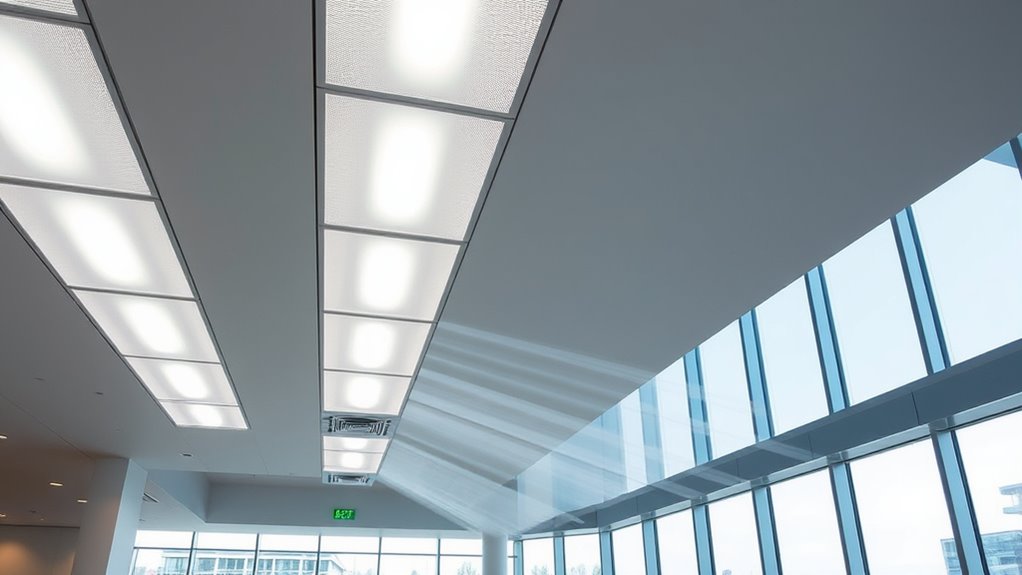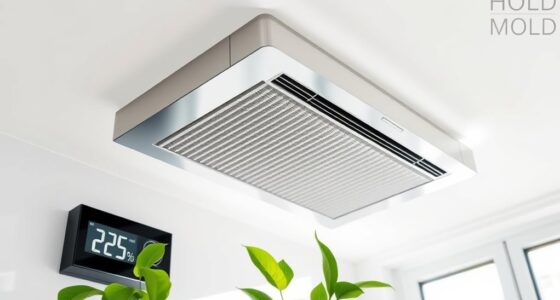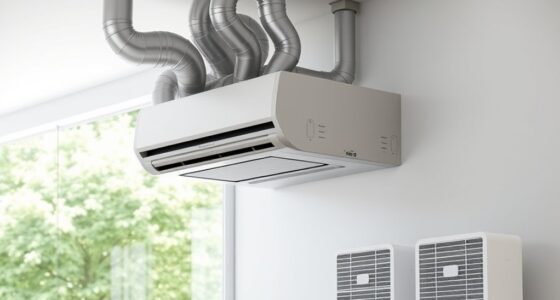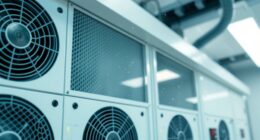Chilled beams and displacement ventilation improve indoor air quality by providing fresh air directly to the breathing zone, reducing pollutant circulation and preventing temperature stratification. Chilled beams use water-cooled panels that efficiently remove heat and humidity without creating drafts, while displacement ventilation introduces low-velocity air at floor level that pushes stale air upward for removal. These systems support healthier environments, and understanding their IAQ benefits can help you optimize indoor comfort and air hygiene. Keep exploring to learn more.
Key Takeaways
- Both systems improve indoor air quality by reducing pollutant circulation and preventing temperature stratification.
- Displacement ventilation delivers fresh air directly to the breathing zone, enhancing IAQ.
- Chilled beams contribute to IAQ by controlling humidity and maintaining consistent indoor temperatures.
- Low-velocity airflow in both systems minimizes drafts and airborne particle suspension.
- Integration with advanced ventilation technologies can further optimize IAQ and energy efficiency.

Have you ever wondered how modern ventilation systems enhance indoor comfort while reducing energy consumption? It’s fascinating to see how innovations like chilled beams and displacement ventilation play a key role in achieving this balance. These systems are designed not only to improve air quality but also to optimize thermal comfort and energy efficiency in buildings. When implemented correctly, they help create a healthier, more comfortable environment while cutting down on energy costs.
Chilled beams work by cooling the air through water pipes embedded in a ceiling panel. As warm air rises, the chilled beams absorb heat, cooling the space efficiently without the need for large, noisy fans or high energy use. This method of cooling is highly effective at maintaining consistent indoor temperatures and humidity levels, which directly benefits thermal comfort. Since chilled beams operate at lower water temperatures compared to traditional air conditioning systems, they consume less energy, making them a sustainable choice for efficient building design. Their ability to deliver precise cooling without creating drafts or uneven temperature zones enhances occupant comfort, especially in large, open spaces where traditional systems might struggle to evenly distribute air.
Chilled beams efficiently cool spaces with water pipes, maintaining comfort and reducing energy use without noisy fans.
Displacement ventilation introduces fresh air at low velocities near the floor level, where it gently pushes stale, warmer air upward toward ceiling vents for removal. This approach ensures a steady supply of high-quality indoor air, reducing the buildup of pollutants and allergens in occupied zones. Because the fresh air is delivered directly to the breathing zone at a slow, controlled rate, it minimizes drafts and temperature fluctuations, supporting consistent thermal comfort. Additionally, displacement systems are energy-efficient since they operate primarily by moving air at low velocities and require less fan power compared to conventional overhead systems. This results in significant savings on energy bills and lowers the building’s carbon footprint. The strategic placement of diffusers and the natural stratification of warm and cool air layers help maintain a comfortable environment, even during peak outdoor temperatures. Moreover, integrating advanced ventilation technology can further optimize indoor air quality and energy performance.
Both chilled beams and displacement ventilation systems contribute to better indoor air quality (IAQ) by reducing the circulation of polluted air and preventing temperature stratification. They support healthier indoor environments by minimizing drafts, controlling humidity, and ensuring a steady flow of fresh air. This is particularly important for sensitive populations, like those with allergies or respiratory issues. Together, these systems exemplify how advanced ventilation technology can make indoor spaces more comfortable and energy-efficient. By focusing on precise temperature control and efficient air distribution, they help you enjoy a healthier, more sustainable indoor environment without sacrificing comfort or increasing energy costs.
Frequently Asked Questions
How Do Chilled Beams Affect Humidity Control?
Chilled beams impact humidity control by assisting with moisture management and maintaining proper humidity regulation in your space. They cool the air through conduction, which helps remove excess moisture and prevents humidity levels from rising too high. This passive process supports a comfortable environment, reducing mold risk and improving IAQ. However, you should monitor humidity levels closely, as excessive cooling can sometimes lead to over-drying or condensation issues if not properly managed.
Can Displacement Ventilation Reduce Energy Consumption Effectively?
Yes, displacement ventilation can dramatically cut your energy bills! By targeting clean air precisely where it’s needed and reducing the load on cooling and heating systems, it boosts system efficiency and slashes energy consumption. You’ll notice the difference through lower utility costs and a more sustainable environment. So, switching to displacement ventilation isn’t just smart; it’s a game-changer for energy savings and optimizing your building’s overall system performance.
What Maintenance Is Required for Chilled Beam Systems?
You need to regularly inspect and clean the chilled beam system to guarantee its longevity. Check for any buildup of dust or debris and replace or clean filters as needed, since filter requirements help maintain air quality and system efficiency. Additionally, monitor for signs of corrosion or leaks, and schedule routine maintenance to keep the system running smoothly. Proper upkeep maximizes performance and extends system lifespan.
Are There Health Risks Associated With Displacement Ventilation?
Yes, displacement ventilation can pose health risks if not properly maintained. You might find indoor allergens accumulating if filters aren’t regularly replaced, which can affect air purification. Poor maintenance can lead to mold growth or dust buildup, impacting IAQ. To minimize risks, verify your system is cleaned frequently, filters are changed on time, and air quality is monitored, helping keep indoor allergens at bay and supporting healthy air quality.
How Do These Systems Perform in Extreme Climate Conditions?
In extreme climate conditions, these systems face challenges but can still perform well if properly designed. They offer good thermal performance by adapting to temperature variations, maintaining comfort. You should guarantee system adaptability by incorporating supplemental heating or cooling options, especially in very hot or cold environments. Proper insulation and controls help these systems efficiently handle extreme conditions, ensuring IAQ and comfort aren’t compromised.
Conclusion
By choosing chilled beams or displacement ventilation, you’re shaping the air you breathe—literally. These systems don’t just cool a space; they elevate indoor air quality, making it healthier and more comfortable. Remember, the right ventilation isn’t just a choice; it’s an essential step toward a better indoor environment. Don’t overlook the power of these systems—they’re the silent guardians of your comfort and health, silently whispering, “Your well-being matters.”










